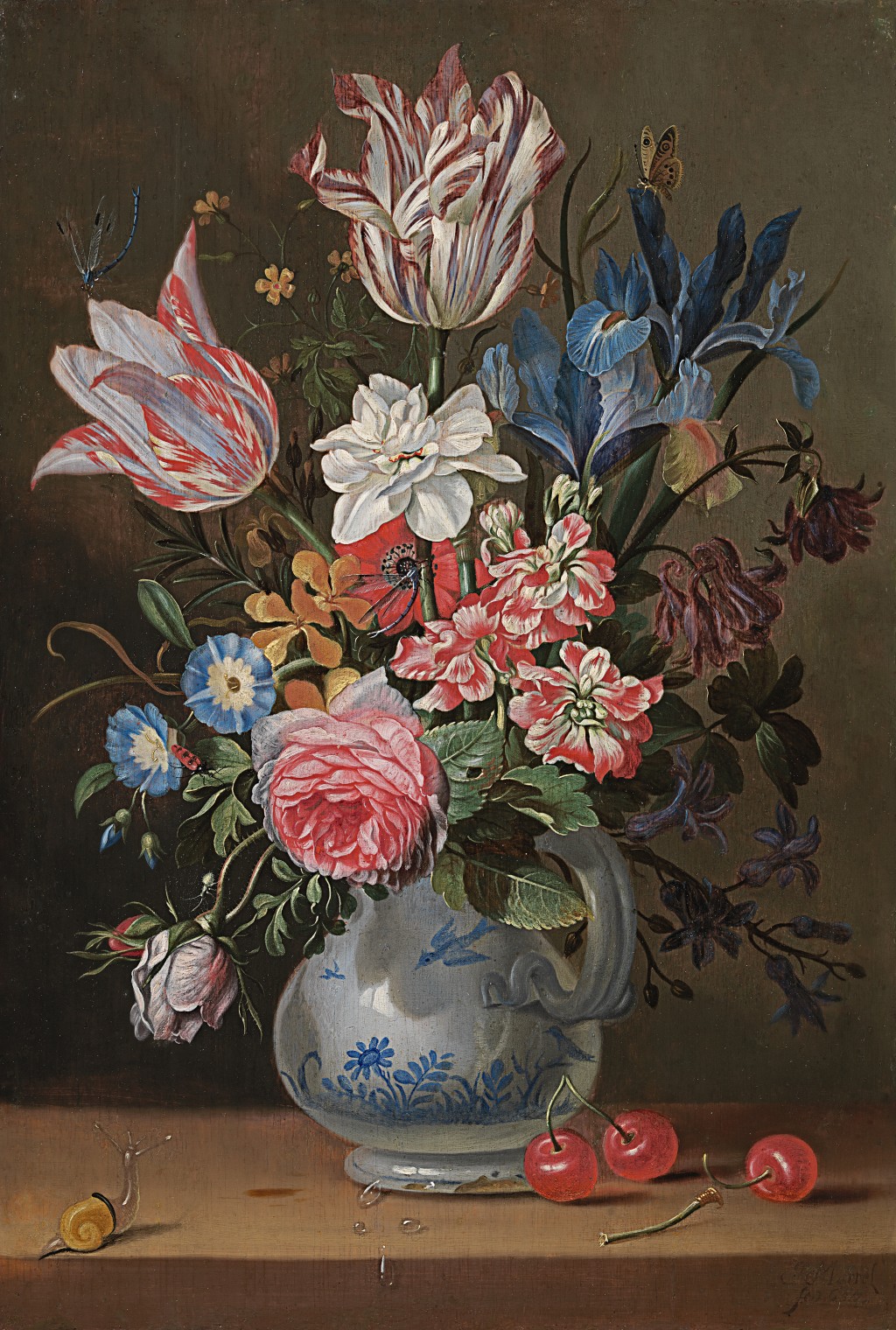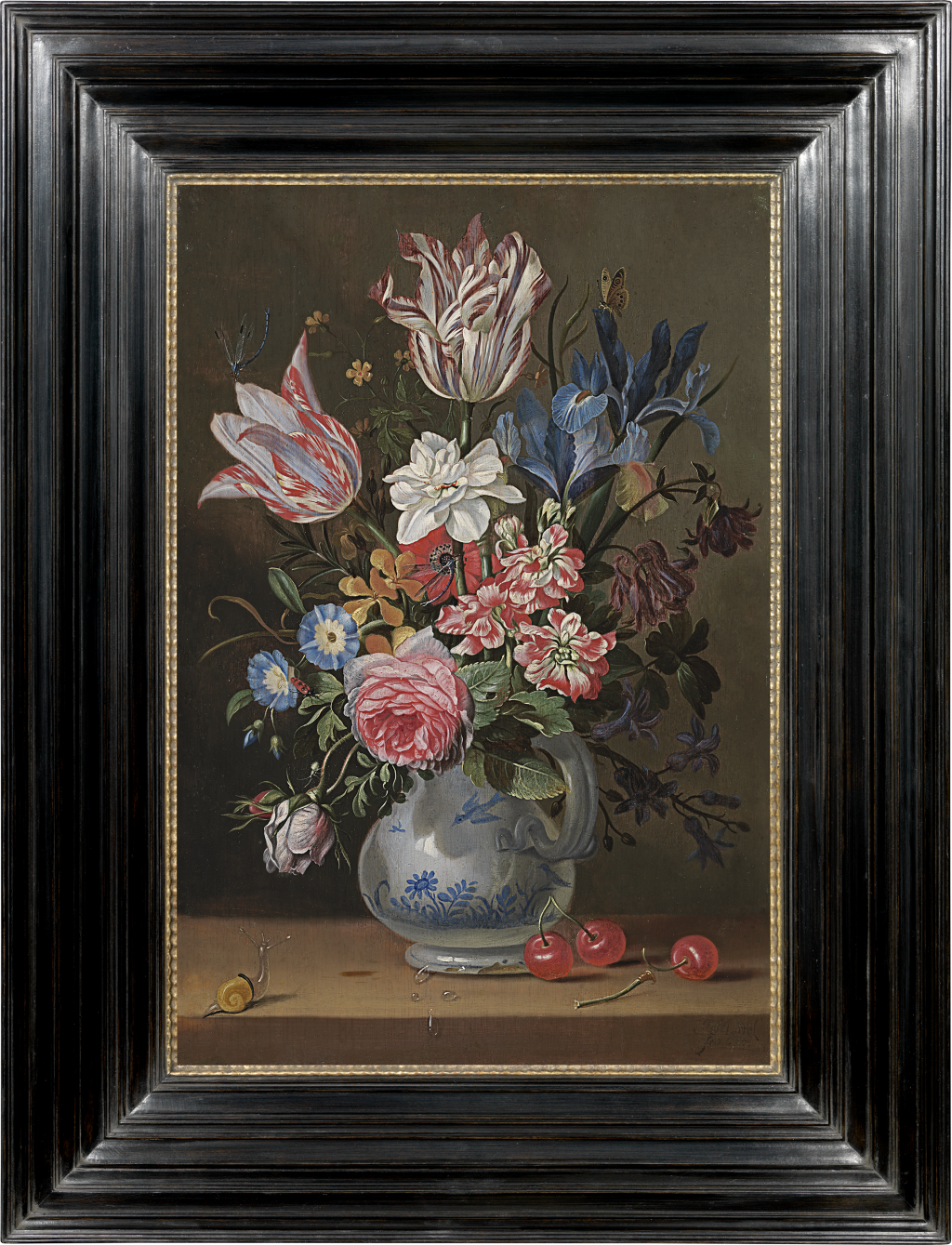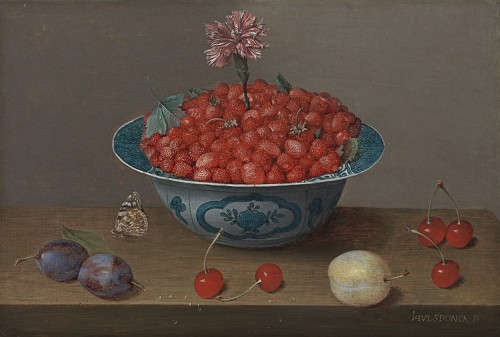JACOB MARREL
Frankenthal 1613/14 - 1681 Frankfurt-am-Main
Ref: CB 229
Still life of tulips, roses, irises, a narcissus, stocks and other flowers in a blue and white vase, with cherries and a snail on a ledge
Signed and dated lower right: .J Marrel / fe 165[7]
Oil on panel: 16 7/8 x 11 ½ in / 42.9 x 29.2 cm
Frame size: 23 ¼ x 18 in / 59.1 x 45.7 cm
Provenance:
Private collector, Europe, by descent from their grandfather
Jacob Marrel was born in Germany and died there as well. Nevertheless, he can be regarded as belonging to the Dutch school, more specifically, the school of Utrecht. At the age of about 14 he became a pupil of the still-life painter Georg Flegel (1565/66-1638) in Frankfurt am Main. In or shortly before 1632, about 18 years of age, he came to Utrecht, where he was strongly influenced by painters from what art historian Laurens Bol termed the ‘Bosschaert Dynasty’. It would appear that Marrel was in close contact with Ambrosius Bosschaert the Younger (1609-1645), who was only a few years older than Marrel himself. He stayed in Utrecht for more than fifteen years but must have travelled a lot in the meantime. A vanitas still life from 1637 is inscribed ‘in Francofurth’.[1] Even after having returned to live in Frankfurt around 1650 and staying there more or less permanently for the rest of his life, Marrel must have travelled to the Netherlands quite often. In 1664 he brought his pupil Abraham Mignon (1640-1679) to Utrecht, where the latter started working with Jan Davidsz. de Heem (1606-1684). Apart from being a painter, Jacob Marrel was also active as an art dealer, which may account for his frequent travels and which probably gave him the opportunity to study other artist's works closely on a regular basis. In addition to being an artist in his own right, Marrel was an eager copyist and imitator, apparently absorbing influences like a sponge. After working predominantly in the manner of the Bosschaerts, during the second half of the 1640s, his work started to show a strong influence of de Heem, who was still working in Antwerp at the time. Several excellent copies after works by de Heem signed by Marrel are known.
This flower painting is a fully characteristic, relatively late work by Jacob Marrel, painted after his return to Frankfurt, as its date 1657 (or 1652?) also indicates. The flamed tulips are almost signature flowers for the artist; similar tulips can be found in many of his paintings, but also in the tulip books he produced. Snails are also frequent guests in Marrel’s paintings; this one appears to be curiously looking up at the bouquet. Almost the same snail features in an earlier painting, form c.1640, there facing away from the bouquet, however (fig. 1). Similar snails can be found in other works by Marrel from the 1650s (cf figs 3 and 4). Jacob Marrel mainly depicted his flowers in vases, often bulbous glass ones, but occasionally vases in porcelain or other ceramics, like here, a tin-glazed jug with manganese blue decoration. Such vases start to appear after Marrel’s move back to Frankfurt (cf. figs 2-5). While they are reminiscent of Delft blue ceramics, they were probably produced in Frankfurt, which had an emerging faience production at that time. Frankfurt potters, like their counterparts in Delft, were looking at Chinese porcelain for inspiration (fig. 6).[2] Jacob Marrel was fond of placing a few cherries on the ledge in his flower paintings, as he also did here. They appear throughout his oeuvre.
Also from the 1650s and reminiscent in handling to the still life discussed here are a few garlands of flowers (cf. figs 7 and 8). The flowers in the painting in Frankfurt from 1651 (fig. 7) surround a city view of Frankfurt, based on a design by Matheus Merian the Elder (1593-1650).
While Jacob Marrel produced many tulip drawings for tulip books, he does not appear to have used those as models for his paintings. And while the vast majority of his flower paintings include tulips, he hardly ever seems to have repeated a tulip in more than one painting, which was common practice for many of his contemporaries, such as Balthasar van der Ast. Consequently, while the tulips in the tulip books are all adorned with (often fancy) names, none of the tulips in Marrel’s paintings can be identified by such a specific name.
The iconography of this still life is probably not very profound. There is the usual vanitas connotation of the flowers themselves, which bloom only briefly and wither soon, which can remind the viewer of his own mortality. The sense of oncoming decay can also be found in at least one rose leaf that has been gnawed by insects. Also, the Four Elements may be recognised: the flowers and cherries can represent Earth, the dew drops Water, the flying creatures Air, while the vase, as a product of Fire can represent that element. But above all, this is a highly charming arrangement of beautiful flowers, for the viewer to enjoy.
Fred G Meijer
1 Jacob Marrel, signed, oil on panel, 22 ¾ x 19 in / 57.8 x 48.8 cm. Art market, 1997.
2 Jacob Marrel, signed and dated 1656, oil on canvas, 24 x 20 ½ in / 62 x 52 cm. Art market, 2022.
3 Jacob Marrel, signed, oil on canvas, 21 ¼ x 15 ½ in / 54 x 39.5 cm. Art market, 2023.
4 Jacob Marrel, signed, oil on copper, 16 ½ x 13 ¼ in / 42.3 x 34 cm. Private collection.
5 Jacob Marrel, signed and dated 1665, oil on canvas, 32 ¾ x 22 ½ in / 83.3 x 57.1 cm. Private collection.
6 German (Frankfurt?) faience vase, seventeenth century, height 19 cm. USA, Antiques market, 2024.
7 Jacob Marrel, signed and dated 1651, oil on canvas, 41 x 32 ¼ in / 104 x 82 cm. Frankfurt am Main, Historisches Museum, inv. no. B2.
8 Jacob Marrel, signed and dated 1655, oil on canvas, 31 x 26 ¼ in / 79 x 67 cm. Darmstadt, Hessisches Landesmuseum, inv. no. GK 316.
NOTES
[1] Oil on canvas, 36 x 31 ½ in / 92 x 80 cm, signed and dated 1637, Karlsruhe, Staatliche Kunsthalle, inv. no. 2586.
[2] While it is often not easy to distinguish Frankfurt faience from Delftware, it is even more difficult to do so from painted examples.




























